 Values
Reference
Profiles
Exotics
Order
MENU
Values
Reference
Profiles
Exotics
Order
MENU
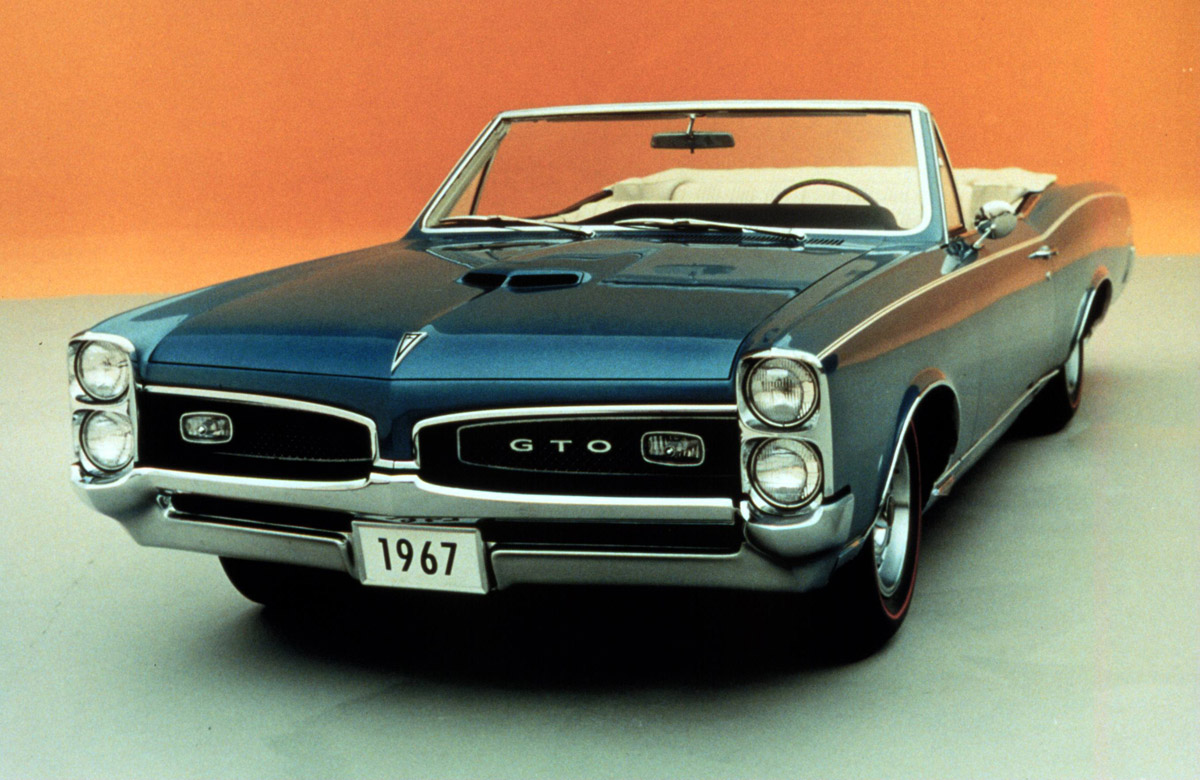
After World War II, a driving factor in American automobile production was the race to put more horses under the hood. This led to some mighty full size performance vehicles such as the Chrysler 300-letter cars, big-block Chevrolets with multiple carburetors and stout four-speeds, and trick intake and valve treatments to FE block Fords.
| Plus | Minus |
|
Iconic status |
Perhaps too many around to break out of its current value range
'64 and '65 models can be "created" without too much effort or skill. |
The cars, the engines and the horsepower kept growing, and the market was ripe for an alternative. In 1962 a new generation of American automobiles was born with the new "mid-size" class, a cross between the full-size behemoths and the fresh compacts that were setting sales records. For Pontiac, their new entry was the Tempest. Evolved from the compact Tempest/Lemans of 1961-63, by 1964 it had shed it's somewhat unconventional engineering and grown enough to be considered a mid-size vehicle. It competed with the likes of the Ford Fairlane and companion GM makes such as the Oldsmobile F-85/Cutlass, Chevrolet Chevelle/Malibu and Buick Special/Skylark.
Almost immediately the top folks at Pontiac, considered the most youthful division at GM, started to develop an idea for a super-model of the Le Mans. Division head John Z. DeLorean had the idea for the car and Jim Wangers had the knowledge and skill to develop such a vehicle. Unfortunately, the big bosses at GM headquarters didn't share the same excitement and enthusiasm of DeLorean and Wangers, and put a hold of the production plans for such a car.
A scheme was devised to work around the corporate roadblock and shortly after the introduction of the 1964 models a LeMans with a special G.T.O. (Gran Turismo Ologatto) package was released. While the GM brass had forbade a super model, DeLorean and Wangers noted that there was no such limitation on an option package! Within days of its release the press wrote reports that seemed like they came from Pontiac's own PR department. Early fans gave the GTO the nickname of "goat", a true term of endearment from those who appreciated the risks taken by those within the Division.
Under the hood was a base 389cid V8 with 325hp, a four-barrel intake and dual-exhausts. Optionally available was a tri-power set-up that upped the horsepower to 348. A three-speed transmission was standard, with either an optional automatic or four-speed available at extra cost. All transmissions came up through the floor for a sporty appearance. Automatics got a 2.93:1 rear axle ratio, with the manual shift transmissions coming with a 3.08:1 rear end. Later in the model year, optional gears up to 4.11:1 were available for dealer installation.
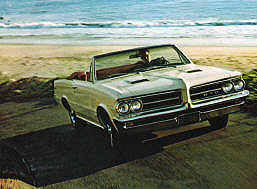 1964. This is what the start of the modern muscle car era looked like.
1964. This is what the start of the modern muscle car era looked like.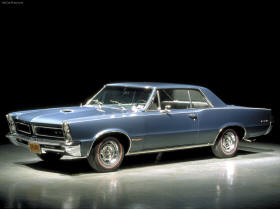 The '65 was new, but unmistakenly GTO.
The '65 was new, but unmistakenly GTO.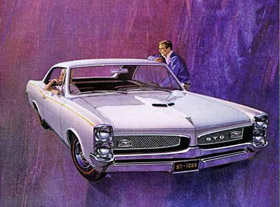 This '67 reflects the all-new styling introduced in '66.
This '67 reflects the all-new styling introduced in '66.
Standard steering weighed in with a 24:1 ratio, but a quicker 20:1 was available for more responsive handling. Power steering was also available but only a 17.5:1 ratio was offered with this convenience. Other suspension modifications included strong shocks and springs, and the wheels were shod with 7.50" x 14" redline tires.
Adding to the GTO aura were exclusive all-vinyl interiors with front bucket seats and full bench rear, instrument panel decor appliques, and at a slight additional cost, a center-shift console. The GTO package could only be ordered for three LeMans body styles: the two-door sedan, hardtop and convertible. A new type of American automobile was born, the Muscle Car.
The response from the public was strong and performance-minded Pontiac fans flocked to the showrooms to get their dream car. A big engine in a small car body and chassis was a formula that other carmakers would soon be copying. While the head honchos in the GM headquarters building were not all that happy with the end-run played out by Wangers and DeLorean, they quietly acquiesced when the sales started pouring in.
What this meant was that the 1965 edition would be that much bolder. From the outside there was no mistaking a GTO from the base Le Mans. Even though both shared new sheet metal and basic styling traits, identifying the GTO was a little easier than in the first year of production.
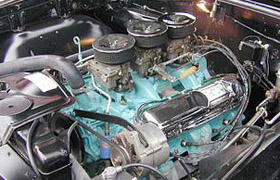 '65 389 3x2v with 360hp. 348hp for '64.
'65 389 3x2v with 360hp. 348hp for '64.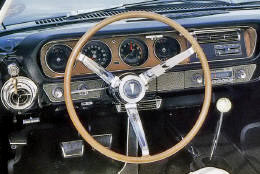 65 dash with rare a/c and 4-speed
65 dash with rare a/c and 4-speed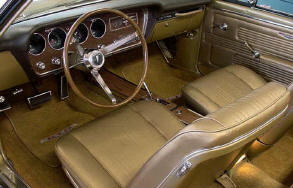 The '67 interior is well appointed -- with a hint of Ferrari.
The '67 interior is well appointed -- with a hint of Ferrari.
A new hood with simulated hood scoops, special blacked out front grille, unique pin striping, strong series identification, and 7.75" x 14" red-line tires graced all GTOs. Under the hood the base GTO engine gained 10hp to 335, while the tri-power set-up was bumped to 360hp. A rare (about 200) dealer installed, functional ram air system was available that was incorporated into the fake hood "scoop", undoubtedly coaxing a few more ponies out of the tri-power mill. An engine dress-up kit was standard and included chrome valve covers, oil filler cap and the air cleaner housing.
Other GTO touches included a grab-handle, deluxe steering wheel, interior identification and a Hurst shifter for manual transmission units. The dash was revised slightly, with the tach moving toward the center of the cluster next to the speedometer. The result was an increase in production.
Finally, General Motors realized the influence that the GTO had on other models of the Pontiac division, as well as the muscle cars now being marketed by other GM Divisions, and allowed the car that started the craze to have its own identity. For 1966, GTO was no longer an option package for LeMans, but was considered a model in its own right. It was still offered in three body styles, pillared coupe, hardtop coupe and convertible. While styling was basically an update from 1965, it's flowing lines suggested a bit more luxury and sophistication. The most important feature was the performance, and the best just got better. The base 389 with a four-barrel intake was still listed at 335 horses, and the tri-power at 360hp with either the manual or automatic transmission.
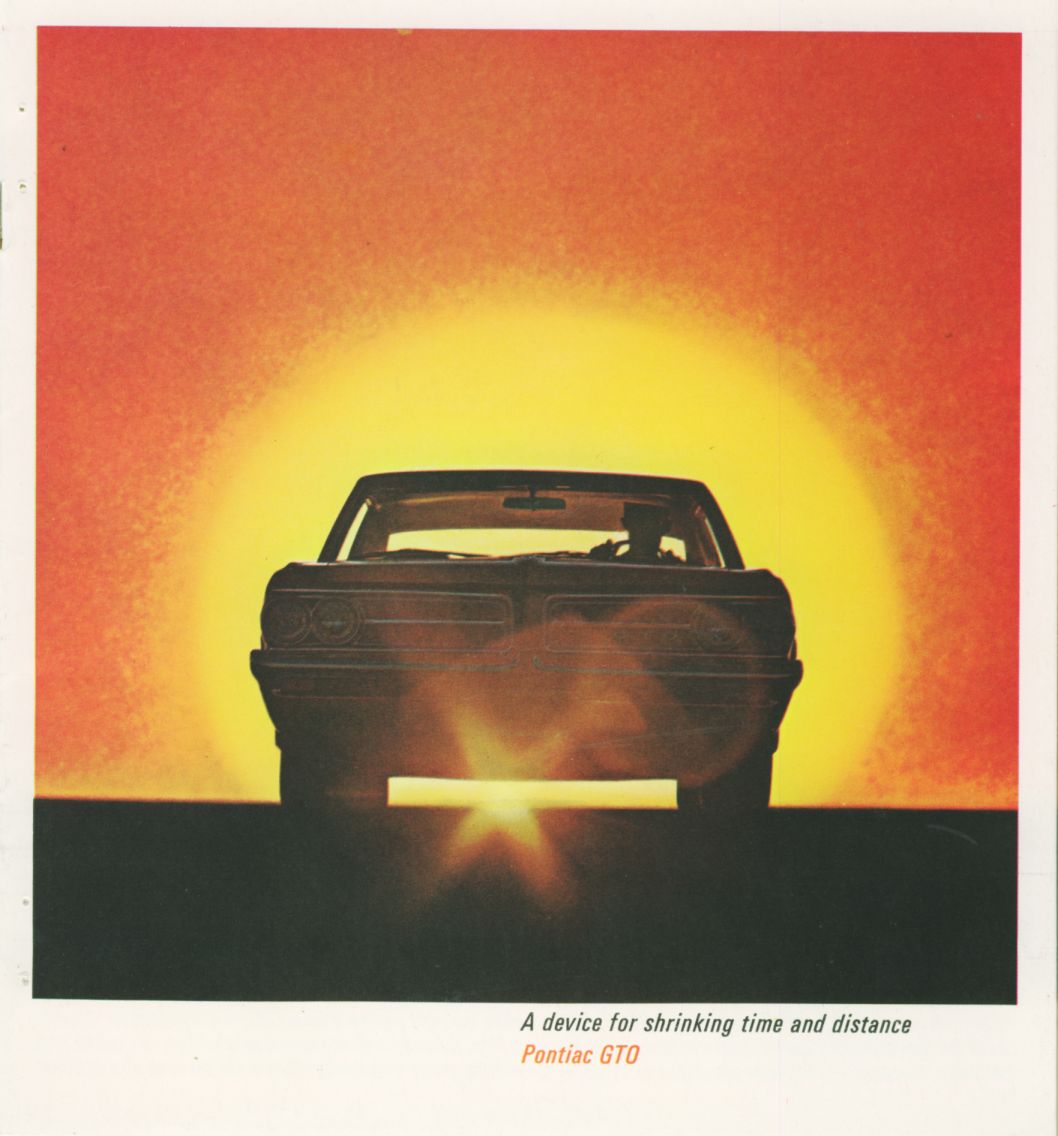
Clever advertising, word of mouth and even a popular song by Ronnie and the Daytonas and then covered by the Beach Boys ("Little
GTO"), sales continued to climb as performance minded buyers were flocking to dealerships. Even if they couldn't afford a GTO, the Le Mans and other Pontiac models benefited from the increased traffic. Not only was the brand winning in the showroom, a number of GTO's were campaigned in special NHRA competition classes, and, of course, on nearly every local back street in America.
Although the GTO was considered an independent model, its basis was still the Tempest/LeMans package. A mild facelift greeted buyers in 1967, but the big news wasn't sheet metal or chrome trim, but rather a new, larger V8. The new 400 cubic inch mill was still rated at the same 335hp as the 389, and the performance version also maintained the previous rating at 360hp.
GTO's popularity continued to grow on the street and on the strip, and increased sales at Pontiac were attributed to the "halo" of the GTO. Some of the thunder of GTO started to fade a little this year as a major amount of promotion went into Pontiac's newest performance entry, the Firebird. Built (along with its sister the Camaro) to grab some of the strong sales of the smash-hit Ford Mustang, it would be Firebird's time to shine, but true performance enthusiasts still had their love affair with the "Goat".
GTO continued to be a major player, but not the dominant one, in the performance muscle car scene for several more years. After 1971, Federal restrictions and major insurance increases relegated all muscle cars to becoming more appearance than performance, and the last of the "real" GTOs was seen in 1974.
Authenticating
Because the 1964 GTO was a performance option package on the Le Mans series, there is no way to distinguish a real GTO just from the vehicle identification number, or VIN. However, due to the exclusive interior trim used by GTO, consulting the build plate attached to the firewall/cowl assembly under the hood can help sort out a car's authenticity. Six exclusive all-vinyl trims were used, which were coded 214, 215, 216, 217, 218 and 219. These represented black, dark blue, saddle, dark aqua, medium red and parchment respectively. A similar situation also exists for the 1965 GTOs with exclusive soft trim codes running from 213 to 218.

When the GTO became a separate model in 1966, both the VIN and the body tag reflected this status. A typical VIN for a 1966 GTO wold be 242176P123456. The first "2" represented the Pontiac line, while the most important digits were the "42" that followed indicating a GTO. The following two digits, "17" in this case, indicated the body style (two-door hardtop), while the "6" showed the model year, and the "P: the assembly plant, followed by the unit sequence. On the body tag under the hood, the "Style" code would also indicate the GTO model, starting with a "66" for the model year, followed by 24217, the two again representing the Pontiac, the "42" for GTO, and the "17" the two-door hardtop. This same coding system was used for 1967 also, with a "7" or "67" replacing the "6" or "66" as the model year indicator.
Engine block numbers can also be referenced to ensure authenticity, at least down to the proper date and type. The body tags include information about the original soft trim and exterior paint colors, as well as the week and the month the car was assembled.
The GTO was very popular when new and a good number of these cars were built. Survivors, though, are becoming harder to find. First owners usually bought the cars to drive and enjoy them, not to cherish them as collector's items. When a new and more powerful version was introduced, the first editions were sold off and often fell into the hands of less experienced--and less caring--drivers, which resulted in the loss of many through neglect, abuse and plain old age. By the end of the 1970s, when these cars were just 15-16 years old, the importance of the GTO started to come to light and those that were still around were soon being cared for and preserved for their heritage. By the time the first GTOs celebrated their 25th Anniversary in 1989, several organizations had been formed to serve as a home base for GTO fans.
Almost unbelievably, it's been nearly forty years (2019: 55 years!) since the first Pontiac GTOs arrived on the scene, and today authentic versions are among the hottest trading muscle cars on the market. (Update 2019: While longer true, these are still desirable muscle cars and pretty high up on the pecking order) First year convertibles in #2+ condition can easily fetch well over the $30,000 mark, even more with with the 3x2bbl setup. Comparable hardtops and coupes command $20,000 plus. (Update 2019: Values are now over the $50,000 mark for 4bbl convertibles, and around $35,000 or so for hardtops. You can add another 20% for exceptional examples.)
The 1965 model year also enjoys a strong following. One might think that with the later models, prices might falter a bit, however, these are among the most popular of the breed, and when properly equipped can fetch prices higher than the original model.
As a whole, muscle car prices peaked in the late 1980s and early 1990s, followed by a general decline that affected the entire collector car market. During the latter part of the 1990s, these American powerhouses led a resurgence in collector car values, but the last several months have seen a general leveling off of GTO values, and indeed all muscle cars appear to be taking a breather after the increases of the late nineties through 2002. With the economy rebounding, it's likely they'll head up again.
For the thrill and excitement of an American born and bred performer, one that was born a little bit outside of the rules from GM, the early GTO can't be topped. If you love muscle, sooner or later you have to get your own "goat".
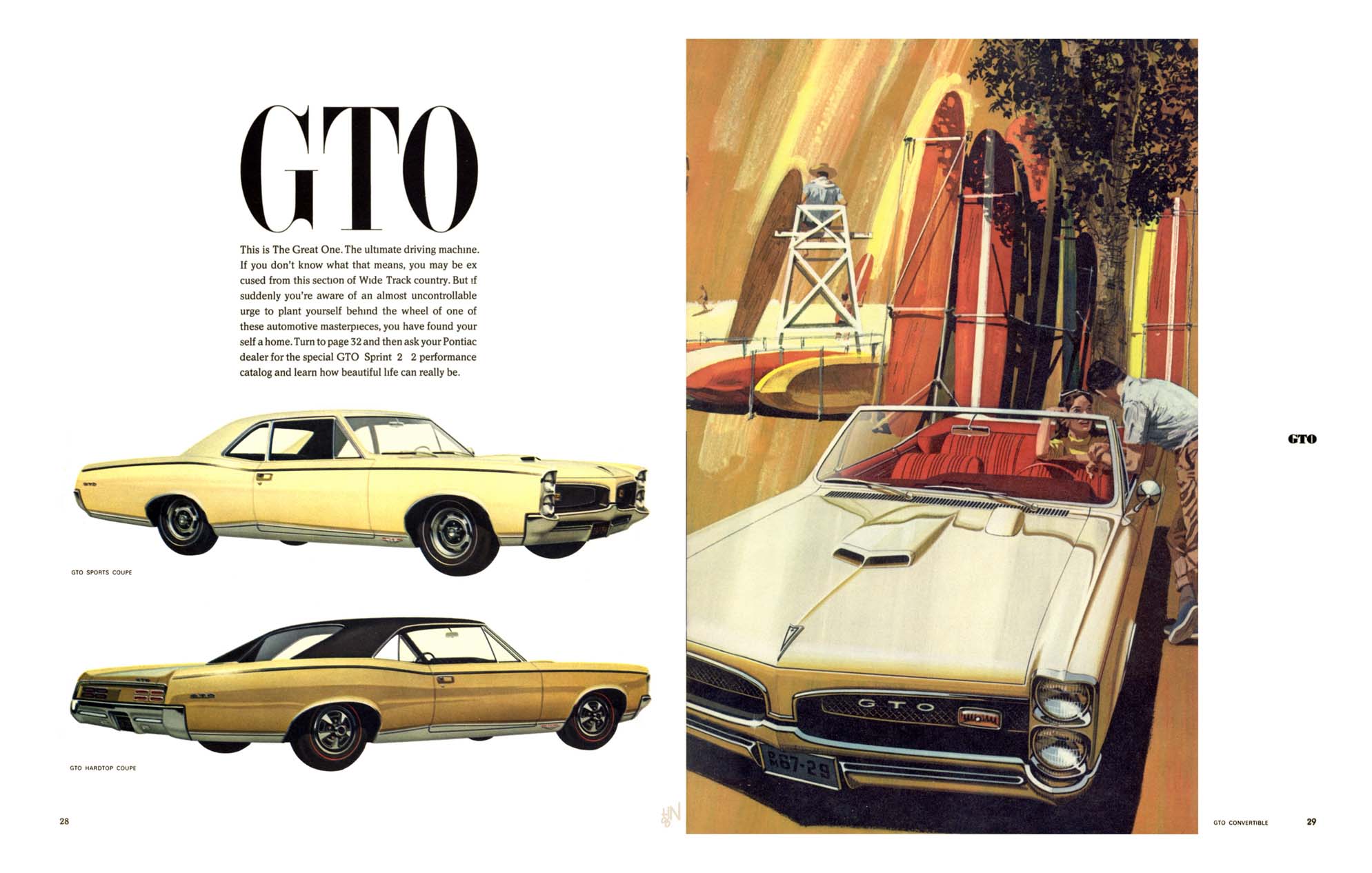
(C) Copyright 2003- VMR International, Inc. All rights reserved. This article first appeared in the July 2003 issue of Collector Car & Truck Market Guide.